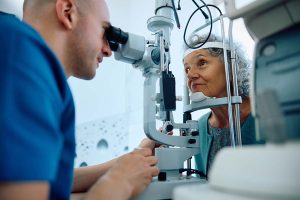
A team of Johns Hopkins researchers has developed a new way to more reliably predict which patients with glaucoma are at risk of further vision loss.
Glaucoma, a serious eye condition that can cause blindness if left untreated, is caused by elevated intraocular pressure (IOP), measured by the puff of air against the cornea familiar to anyone who has had an eye exam. Why IOP causes glaucoma is not fully understood, and even after treatment, about 15% of people with the condition still lose some vision, and about 5% go blind in both eyes. The Hopkins team, led by Vicky Nguyen, Marlin U. Zimmerman, Jr. Professor in the Whiting School of Engineering’s Department of Mechanical Engineering, found that using an imaging method to measure strain in the tissues that support the axons—the slender, fiber-like projections that extend from the retina to the brain—could provide important clues about which patients are at risk of suffering these outcomes.
“Preliminary data shows that strains in the tissues supporting the axons measured after the change in pressure may, in some patients, be predictive of glaucoma progression,” said Nguyen, also an instructor in WSE’s Engineering for Professionals program. “So that’s a very promising way of saying that we believe there’s a biomechanical marker that we can use to help diagnose and more aggressively treat those patients most at risk.”
“Long-term Remodeling Response in the Lamina Cribrosa Years after Intraocular Pressure Lowering by Suturelysis after Trabeculectomy”
appears in Opthalmology Glaucoma.
The researchers used a method called digital volume correlation (DVC) to measure patients’ IOP levels. DVC takes 3D measurements of an object’s structure—in this case, the tissues of the optic nerve head—and can detect abnormalities by analyzing the image patterns. Nguyen’s team looked at glaucoma patients who had undergone a trabeculectomy—a surgery that creates a new pathway for pressure-causing fluid inside the eye to be drained—followed by suture lysis, a standard follow-up procedure to relieve pressure further.
Nguyen’s team, working with Harry Quigley, doctor of ophthalmology at the Johns Hopkins School of Medicine, examined glaucoma patients at the Wilmer Eye Institute. They imaged the optic nerve head using optical coherence tomography, which bounces an infrared light wavelength off the eye’s internal tissue structures. The patients were imaged directly after undergoing surgery to lower their IOP and between one and four years afterward. The researchers focused their analysis on the lamina cribrosa, a mesh-like structure in the back of the eye that supports the axons as they exit the eye to form the optic nerve cable. By correlating the two sets of images, they calculated how the shape, volume, and position of the lamina cribrosa changed over time, a process referred to as remodeling, after undergoing surgery.
The team found that the eyes that experienced greater remodeling of the lamina cribrosa experienced a worsening of their vision loss. Furthermore, eyes that deform more with the IOP reduction by glaucoma surgery experienced greater vision loss.
“This suggests that short-term lamina cribrosa strain measurements may provide biomarkers for glaucoma susceptibility,” Nguyen said. “Our method is a step forward in how we evaluate the progression of glaucoma and the risk of vision loss to patients.”
Nguyen recently received funding from the National Institutes of Health to further fund this research.